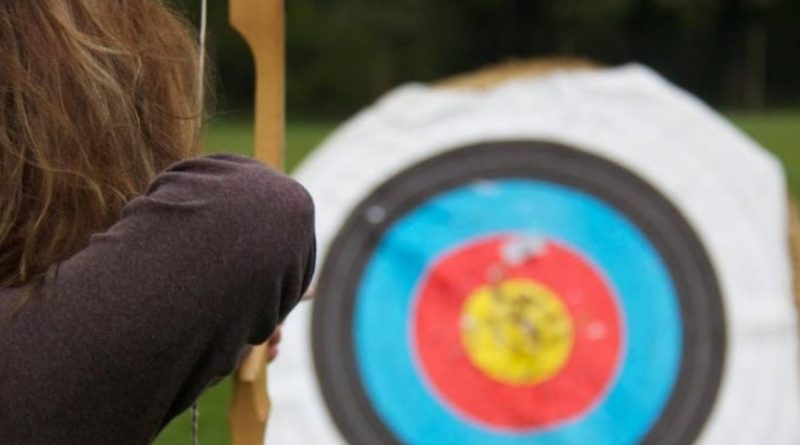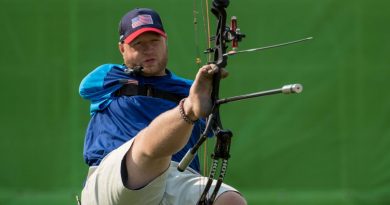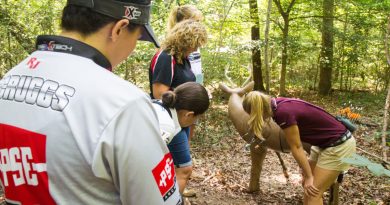Which Archery Target Do I Need?
Archers shoot big targets, little targets, bag targets, block targets, 3-D targets and more! The archery market offers many sizes and styles of targets, so let’s find one that’s right for you.
Tina Robb is a competitive recurve archer, USA Archery Level 3 coach, and program manager at Archery Headquarters in Chandler, Arizona. Robb uses and sells nearly every target available at archery stores nationwide. Below we discuss five types of targets, and learn which ones Robb recommends to her clients and customers.
But first, let’s review some definitions and determine your needs.
Basic Terminology
A “bale” refers to the target and the material it’s made from, such as hay, straw, cloth rags, high-density plastic foam, or foam scraps or layers. Some archers make target bales from compressed carpet, and materials like old clothes, cardboard, newspapers or magazines.
A “face” refers to the paper target you attach to your bale. Target faces come in 40-, 60-, 80- and 122-centimeter diameters. Make sure your bale is big enough for the target face you choose.
Quick tip: Beginners should start with a large bale and target face to ensure they don’t lose or ruin arrows that miss the mark.
Identify Your Needs

Beginners should start with a large bale and target face to ensure they don’t lose or ruin arrows that miss the mark. Photo Credit: USA Archery
Your archery goals and equipment determine the target you need. Will you shoot daily, weekly or monthly? Will you shoot inside or outside? Do you shoot a recurve or compound bow? Will you draw 15 pounds or 50? Your answers will help you choose the right target, no matter your goals, budget or equipment. So let’s weigh your options.
Hay Bales

Hay will often deteriorate quickly outdoors and even get munched by animals, so you’ll replace them often. It helps to cover them with a tarp or keep them in a barn or garage. Photo Credit: Clearwater Cottage Blog
Hay bales are made from herbaceous plants that were cut, dried and packed together. They’re suitable for beginners because they’re big and cheap, and arrows penetrate them easily. Youths and others shooting low-poundage bows have no problem getting arrows to stick in hay bales, which can also handle large target faces.
Hay bales, however, deteriorate quickly outdoors and even get munched by animals, so you’ll replace them often. It helps to cover them with a tarp or keep them in a barn or garage, but their bundles soon collapse when shot often.
You can often buy hay bales from stores that serve farmers and gardeners, such as Lowe’s, Walmart, Tractor Supply Co., The Home Depot and Mills Fleet Farm. Call first or visit their websites to confirm they carry hay bales.
Bag Targets

Beginners might also struggle to hit these smaller targets. Hang or mount bag targets off the ground so you don’t shoot downward at them. Photo Credit: ducsauce via Photobucket
Bag targets have a thick shell, usually woven polypropylene, and are stuffed with cotton or plastic-foam scraps. These midsize, inexpensive targets are easy to find, and they’re great for novice compound archers. They’re also portable, and can be quickly moved inside to avoid rain and sunlight, which degrade the material.
Youths and recurve archers might discover their arrows don’t always penetrate the bag’s tough, pliable surface. Beginners might also struggle to hit these smaller targets. Hang or mount bag targets off the ground so you don’t shoot downward at them. Secure them tightly so they can’t tip over backward or fall forward onto your arrows.
Robb recommends Morrell’s NASP Youth Target. Find it here. Another good option is the Hurricane Bag Target.
Layered Foam Block Targets

They hold up well and don’t shed residue as readily as bag targets do, unless you practice with broadheads. Photo Credit: kingsheath-archers.com
As their name implies, layered foam targets are made from plastic-foam layers. They’re great for archers who shoot regularly. They hold up well and don’t shed residue as readily as bag targets do, unless you practice with broadheads. Don’t leave these targets outdoors, and don’t shoot into the same spot day after day. Those actions weaken these targets and shorten their lifespan.
Robb recommends the Morrell Yellow Jacket Stinger Field Point Target, which has 38 foam layers. Find it here.
Solid Foam Block Targets

Most modular foam targets have replaceable sections that renew their life after countless shooting sessions. These targets are expensive, but their high-quality designs make them last. Photo Credit: Jake Kaminski via Facebook.
Solid foam targets can handle repetitive daily shooting by advanced archers because they’re made of high-density plastic foam. They usually have long lifespans and can tolerate weather, making them great for outdoor use. Most modular foam targets have replaceable sections that renew their life after countless shooting sessions. These targets are expensive, but their high-quality designs make them last.
Robb recommends Rinehart’s FITA Wave Target, which features high-density foam and five sections for replaceable inserts. Find it here. If you don’t want to spend that much money, check out the American Whitetail HybriMAT Prodigy Target here.
3-D Targets

Be sure to set up a backstop behind your 3-D target for occasional misses. Photo Credit: sure-shotarchery.net
3-D targets are excellent for bowhunting practice. These life-size animal targets help bowhunters gain perspective and experience shooting at spots not marked by bull’s-eyes. You can also position them to simulate hunting situations. A 3-D target helps you evaluate your shot placement to ensure clean, ethical shots at multiple angles.
These targets can be expensive, but most can handle broadheads, and they have replaceable inserts for their “vitals” section. Be sure to set up a backstop behind your 3-D target for occasional misses. A large piece of plywood or particle board suffices.
Rinehart Targets offers many options in 3-D animal targets, including bears, boars, deer, turkeys, predators and more.
Final Thoughts
As you can see, the target you buy boils down to what you can afford and how long you want it to last. Meanwhile, if your focus is fun, check out these cool targets. And if you’re still unsure what to buy, ask your local retailer for advice. They’re happy to help!
The post Which Archery Target Do I Need? appeared first on Archery 360.
Originally posted 2018-02-10 18:32:45.




